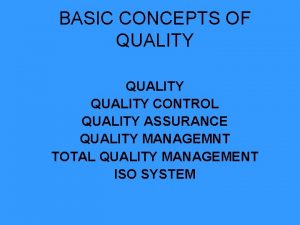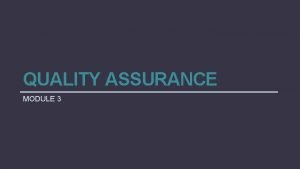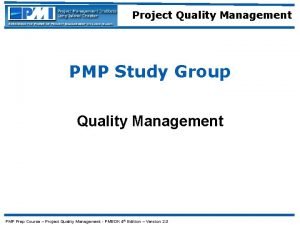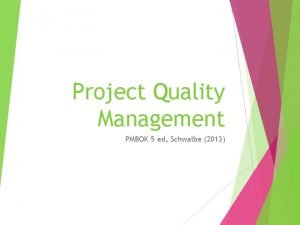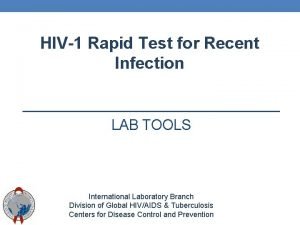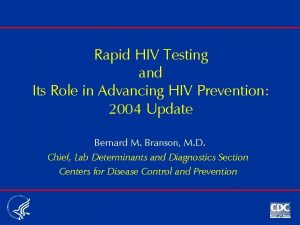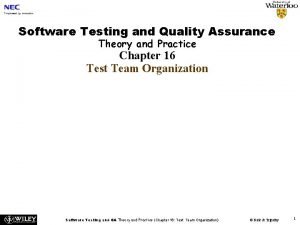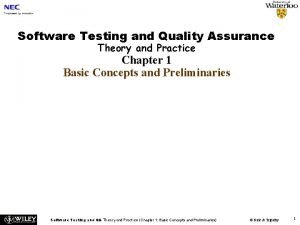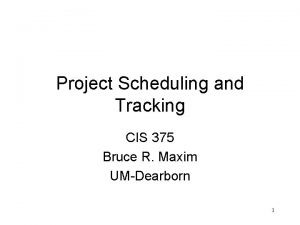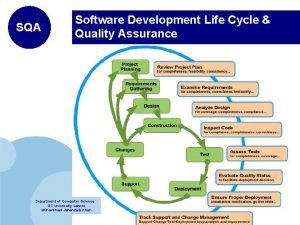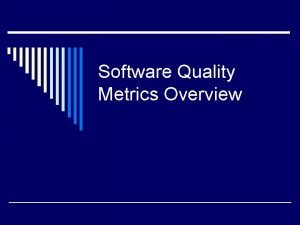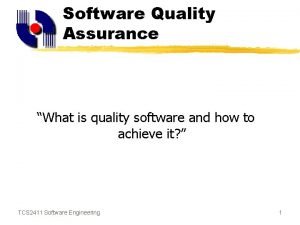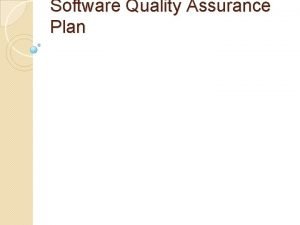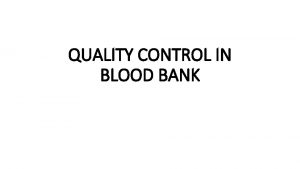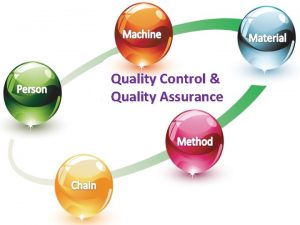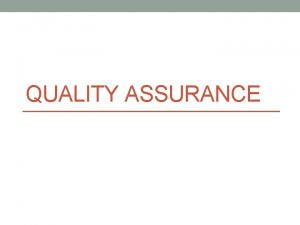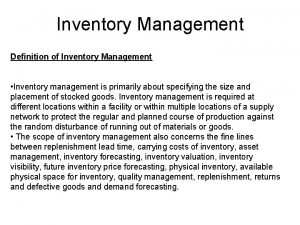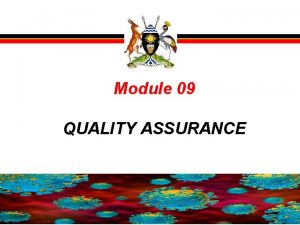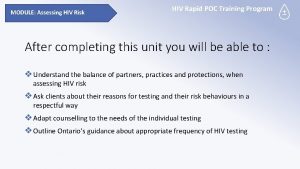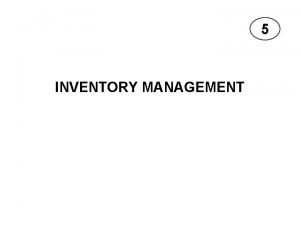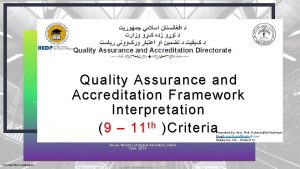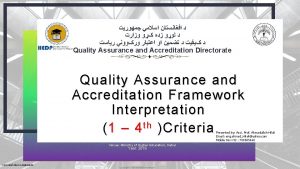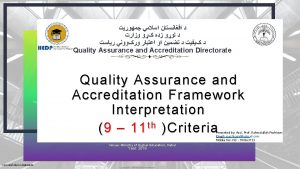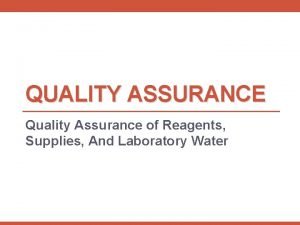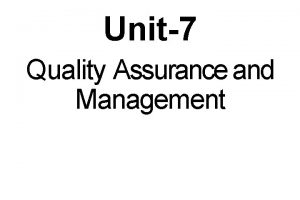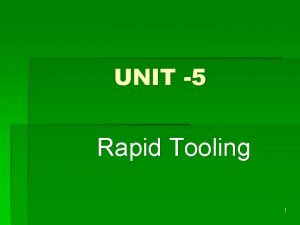MODULE Quality Assurance and Inventory Management HIV Rapid





















- Slides: 21

MODULE: Quality Assurance and Inventory Management HIV Rapid POC Training Program After completing this unit you will be able to : v Understand the purpose of Quality Assurance, the role of the Quality Assurance Lead at your site and how you will support these activities v Understand how test kits are ordered, stored and evaluated; support ordering and inventory management v Perform positive/negative quality control testing of new kits v Understand the ongoing quality assurance processes done at each site and the documentation required

MODULE: Quality Assurance and Inventory Management HIV Rapid POC Training Program Why is Quality Assurance important? v Ensures that your clients get accurate results and high-quality care v Ensures that your site is able to perform accurate testing – necessary to maintain approval for testing at your site v Ensure that all sites in Ontario provide consistent results v Allows the Ministry to monitor the reliability of the kits it purchases All Ontario laboratories perform Quality Assurance testing by law, these procedures have been adapted for point of care testing sites by the Ministry

MODULE: Quality Assurance and Inventory Management HIV Rapid POC Training Program Quality Assurance is Everyone’s Responsibility! HIV test counsellors at your site (like you) the quality assurance lead at your site (may be a supervisor or some other designated individual) the manufacturer bio. Lytical Laboratories Inc. The Ministry of Health and Long-term Care

MODULE: Quality Assurance and Inventory Management HIV Rapid POC Training Program What does Quality Assurance Involve: v Training and updating of staff skills v Monitoring of how test kits are ordered, received, stored and used v Regular evaluation of test kits to make sure they are working properly v Regular assessment of the proficiency of the staff and procedures at your site to ensure correct results In every case, careful record-keeping is essential!

MODULE: Quality Assurance and Inventory Management Manufacturer § Initial quality testing of kits § Provides quality control supplies to sites § Provides Certificate of Analysis for kit lots to Ministry § Responds to any concerns related to test performance The Ministry § Creates training resources & quality assurance direction § First contact for quality issues/ liaison with all § Technical support for investigations § Periodic site audits § Manages online Inventory Management portal for ordering kits, QA supplies, certification panels HIV Rapid POC Training Program IQMH Site Supervisor/ QA Lead § Prepares staff certification panels § Runs biannual Proficiency Testing (PT) Assessment § Distributes PT panels § Manages online Qview Web Portal § Ensure all staff are trained and certified § Oversees the site’s Quality Assurance practices; reviews & approves internal records; takes corrective action as needed § Ensure that the site participates in biannual IQMH PT assessments § Ensures Inventory Management portal is updated regularly § Oversees incident reviews Institute for Quality Management in Health See the Ontario HIV Testing Program website for a complete table of responsibilities. HIV Test Counsellor § Participates in training, certification and proficiency testing (PT) § Does positive/negative quality control testing, temperature recording & inventory ordering, as directed § Maintains daily log accurately § Part of incident reviews

MODULE: Quality Assurance and Inventory Management HIV Rapid POC Training Program Training and Updating of Staff Skills Your Responsibilities ü Participate in new staff training, including these training modules, practical training and mentorship at your site, etc. ü Complete a certification testing panel after your training is complete to fully qualify as a tester. ü Take part in refresher training, after any prolonged absence. Annual refreshers are recommended, particularly for lower volume sites. ü Keep track of the records of your training and make sure you submit them to be placed in your HR file. It is the responsibility of your site and your quality assurance lead to make sure you are trained appropriately.

MODULE: Quality Assurance and Inventory Management HIV Rapid POC Training Program Certification Testing HIV testing sites in Ontario can order certification panels for new HIV test counsellors through the Ministry’s Inventory Management portal. Once you have completed your training, you will participate in this testing. What happens: 1. 2. 3. You receive a panel of samples for HIV testing. The panel is prepared by the Institute for Quality Management in Healthcare (IQMH) Neither you, nor anyone else at your site will know what the results of these tests should be. You will test the samples according to the package instructions. Results of the testing will be available to the administrators of your testing site and through the ministry. If your findings were acceptable, you will be certified as an HIV testing counsellor. Certification panels are not positive/negative quality controls or Proficiency Testing panels. Each of these forms of quality assurance testing has a different purpose and process.

MODULE: Quality Assurance and Inventory Management HIV Rapid POC Training Program Supplies and Inventory Different supplies are ordered from different locations: Inventory Management portal (www. HIVPOCT. ca) – Kits, positive/negative quality controls, and certification panels AIDS Bureau – Additional capillary pipettes, bulb pipettes and tracking stickers to prioritize and direct samples referred to the Public Health Ontario Laboratory (PHOL) – Standard HIV Testing Requisition (online) and Anonymous HIV Testing Requisition (by phone) A quick reference table included with the training materials describes where all needed supplies can be ordered. We’ll talk more about testing requisitions and tracking stickers in the Test Requisition Module.

MODULE: Quality Assurance and Inventory Management HIV Rapid POC Training Program Inventory Management & Supplies Maintaining supplies and ensuring their quality is one of the primary responsibilities of your Quality Assurance Lead. However it is also useful for you to know how these supplies are managed. Alert the lead about damaged supplies, or low supplies of kits or positive/negative quality controls. Your site has a secure user name and password for the www. HIVPOCT. ca portal, which is used to manage your inventory. The portal allows your site to: 1. 2. Order supplies (kits, positive/negative quality controls, certification panels) 3. Enter kit usage information prior to ordering new kits. The necessary information is collected in the monthly summary done by your QA Lead. 4. Review reports of past/current orders and kit usage. Confirm shipment of new kits (not necessary for positive/negative quality controls or certification panels). Kit usage reports help the Ministry track how many kits are needed any problems or errors that may be occurring. Invalid results should be reported as damaged.

MODULE: Quality Assurance and Inventory Management HIV Rapid POC Training Program Inventory Management Portal Your Clinic & Address Summary stats about kit use at your clinic When 500 new kits were ordered in Oct; 72 of the old lot remained. These are flagged as approaching expiry. Usage of kits will have to be updated before any new kits can be ordered Kits, Controls, & Certification Panels last ordered Oct 12, 2018

MODULE: Quality Assurance and Inventory Management HIV Rapid POC Training Program Test Kits – Receiving an Order üMake sure that new orders of test kits are stored in the storage area away from any existing kits, until they can be tested with positive/negative quality controls; all existing lot of kits should be used before starting the new ones. üCheck to make sure the new kits have not been frozen or damaged. üIf asked to do so by the Quality Assurance Lead, test new kits with the positive/negative quality controls Your site is responsible for maintaining an ongoing inventory of your kits at www. hivpoct. ca. Ensure that new kits are not left unattended and that you know who to notify about a new shipment.

MODULE: Quality Assurance and Inventory Management HIV Rapid POC Training Program Test Kits – Storage of Kits Test kits may be stored in a refrigerator or at room temperature, as long as the temperature never exceeds 30° C. The temperature must be recorded daily and range between 2 -30° C. Your temperature gauge should record the high and low temperature each day as well as the current temperature The store room Because low temperature storage is acceptable, kits can be temperature refrigerated to protect them in hot environments. When kits are being must be moved to an outreach site, be aware of the temperature; kits should checked daily never sit out in the sun, or be left in a car trunk in winter. If a temperature outside 2 -30°C is recorded, quality control testing of all stored lots must be done, before further client testing can continue.

MODULE: Quality Assurance and Inventory Management HIV Rapid POC Training Program Evaluating Kits with Positive/Negative Quality Controls Your site should have two vials of quality control material: one HIV-positive and one negative. The positive control is only weakly positive. A reactive test demonstrates that the kits at your site are working in an optimal way. Controls are ordered at www. hivpoct. ca. Control testing should be done: v When the kits are first received before any kits are used (this is sometimes referred to as validating the kits) v If a temperature reading is recorded outside the 2 -30°C range v Monthly on existing kits or every 125 tests completed (not more than once a week for high-volume sites) Controls may be kept frozen or refrigerated for up to a year. Which ever way they are stored, use the expiry date as written!

MODULE: Quality Assurance and Inventory Management HIV Rapid POC Training Program Evaluating Kits with Positive/Negative Quality Controls 1. 2. 3. 4. Take two test kits from the lot you are testing, unwrap the first kit and open vial one as normal Use a bulb pipette to withdraw 50 µl of control from the negative control (up to the pipette’s black line), and add it to vial one; complete testing as normal To test the second kit, use a different bulb pipette to withdraw 50 µl of control from the positive control, and add it to vial one; test as normal It is recommended that the results be recorded on both the Daily Log and the Quality Control Log

MODULE: Quality Assurance and Inventory Management HIV Rapid POC Training Program What if Positive/Negative Quality Control Testing fails? Immediately 1. If the positive is not positive, or the negative is not negative, don’t discard the test material (membrane, etc. ) Take a picture. Both may be used to investigate. 2. Alert the Quality Assurance Lead and/or Supervisor (not required at all sites). 3. Record what happened in the incident log including the expected result, the result obtained and subsequent efforts to resolve the cause of this incident. Second Test 1. Repeat the testing a second time using the same lot of test kits and the same controls. Tests of each control should be done at a time, not simultaneously. 2. If the results are acceptable (as expected), record them in the quality control log and incident log. Testing at your site can continue as usual. 3. Try to identify why the first test came out wrong (i. e. mix up of materials or a missed step) Record in the incident log. The failure of two sequential QC tests is cause for serious concern.

MODULE: Quality Assurance and Inventory Management HIV Rapid POC Training Program If two quality control tests have failed: Have the quality assurance lead conduct this testing whenever possible. Test again (3 rd test) using a different lot of quality controls 3 rd test produces acceptable result; do a fourth test with the same newly-opened quality controls 4 th test result is acceptable. The problem was with the controls. Record in the incident log and order new control. 3 rd test result is un-acceptable (unexpected or invalid result) 4 th test result is un-acceptable (unexpected or invalid result) All testing at your site must stop. Notify the AIDS Bureau Immediately. An investigation must be conducted.

MODULE: Quality Assurance and Inventory Management HIV Rapid POC Training Program Test Kits – Use of Kits üRecord the lot number and expiry date of every kit that you use in the daily log üDo not switch back and forth between different lots of kits. The first kits to arrive should be used first üCheck each kit before use to make sure it has not been damaged bring damaged kits to the attention of the Quality Assurance Lead. üPositive and negative quality control need to be used regularly! üIf a kit does expire, it is sterile. It can be placed in the regular garbage. Please do not use clear garbage bags.

MODULE: Quality Assurance and Inventory Management HIV Rapid POC Training Program Test Kits – Use of Kits What if a kit produced an invalid/unreadable test result when testing a client? When invalid tests happen, don’t discard the testing material (membrane, etc. ) Do a second test If the 2 nd test is valid Record the first and second results in the daily log; counsel the client as normal based on the 2 nd test. Record the first result in the incident log, and carefully consider what may have caused it. Whenever an invalid test happens, take a picture. This photo should be sent to the AIDS Bureau. If the 2 nd test is invalid Recommend the client have a standard test. With client consent, draw blood for the testing. Record the results of both tests on the daily log along with the referral to PHOL. Record both tests in the incident log, and report to the QA Lead for investigation.

MODULE: Quality Assurance and Inventory Management HIV Rapid POC Training Program Assessing Testing Processes at Your Site Rapid testing sites are also expected to evaluate their staff and procedures regularly as follows: v Parallel Testing – Every time a reactive test occurs, clients are advised to confirm the result with standard laboratory testing. This also helps ensure that testing is working well at your site. Report to your Quality Assurance Lead whenever follow-up testing on a reactive rapid test is non-reactive or when a negative sample submitted for standard testing in the window period has a reactive result. v Monthly Assessment of Testing Results – Each month, your Quality Assurance Lead completes a monthly summary of testing at your site including the number of positive, negative and invalid tests done, the number referred to PHOL for further testing, any unanticipated results and kit usage. This information is gathered from the daily log. v Proficiency Testing (next slide)

MODULE: Quality Assurance and Inventory Management HIV Rapid POC Training Program Proficiency Testing (PT) The Ministry has established a regular Proficiency Testing Program for rapid testing sites, administered by the Institute for Quality Management in Healthcare (IQMH). v Your site will regularly receive unknown samples from IQMH to test and return for assessment. v Each of the people who provide testing for clients at your site should participate. v When the results have been analyzed they will be available through the secure Qview portal managed by IQMH. Your Quality Assurance Lead will have access. The Ministry monitors the outcomes of this testing, to ensure that errors are investigated and corrective action taken, as needed. NOTE: Proficiency Testing (PT) samples are NOT positive/negative quality controls or certification panels. Ensure that each package is handled correctly.

MODULE: Quality Assurance and Inventory Management HIV Rapid POC Training Program Summary of Required Logs and Documentation Daily tools that all staff interact with and use regularly v v Rapid HIV Testing Record Daily Log Environmental Monitoring Log A monthly summary usually done by your site’s Quality Assurance Lead Records kept as the activities occur v v Quality Control Log Incident Log These documents might be requested, if an investigation at your site occurred Proficiency Testing Records of Counsellor Training and Certification There is a brief description of each document in your handout; All documentation is stored for 10 years.
 Quality assurance vs quality control
Quality assurance vs quality control Basic concepts of quality control
Basic concepts of quality control Quality assurance module
Quality assurance module Project quality management pmp
Project quality management pmp Quality metrics pmp
Quality metrics pmp Define seminar in nursing management
Define seminar in nursing management Compliance vs quality
Compliance vs quality Asante hiv-1 rapid recency assay
Asante hiv-1 rapid recency assay Hiv positive results images
Hiv positive results images Software testing and quality assurance: theory and practice
Software testing and quality assurance: theory and practice Software testing and quality assurance theory and practice
Software testing and quality assurance theory and practice Software testing and quality assurance theory and practice
Software testing and quality assurance theory and practice Software testing and quality assurance theory and practice
Software testing and quality assurance theory and practice Software testing and quality assurance theory and practice
Software testing and quality assurance theory and practice Software quality assurance tools and techniques
Software quality assurance tools and techniques European quality assurance standards
European quality assurance standards Compartmentalization interdependency effort validation r
Compartmentalization interdependency effort validation r Sqa software development
Sqa software development Classification of software metrics
Classification of software metrics Software quality assurance iso standards
Software quality assurance iso standards Quality control plan software
Quality control plan software Blood bank refrigerator quality control
Blood bank refrigerator quality control

